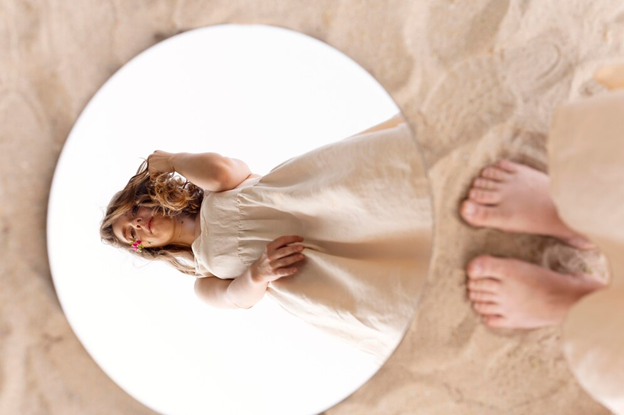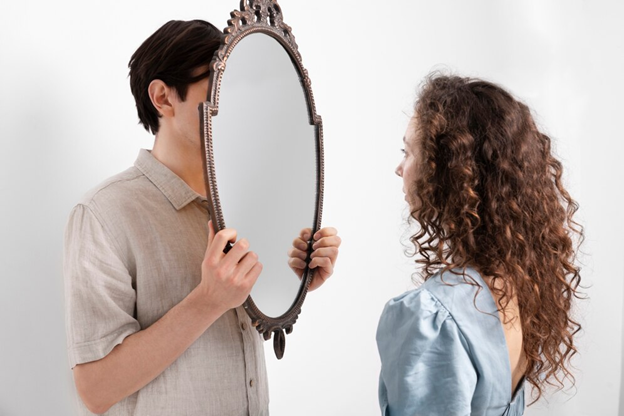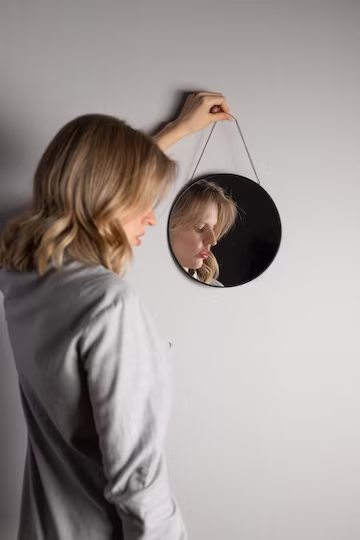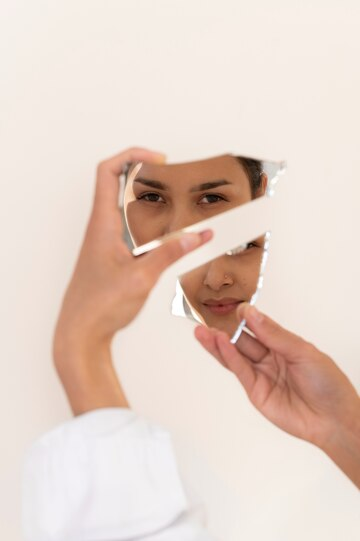The Spiritual Aura of Objects: Breaking Mirrors as an Omen
Mirrors are not just physical reflectors; they embody spiritual reflections of individuals, cultures, and beliefs. Breaking a mirror becomes a spiritually significant event, opening portals to omens, superstitions, and multi-cultural interpretations. The act of breaking a mirror has been imbued with spiritual significance, casting long shadows in the lore and superstitions of many cultures.
Table of Contents
- 1 The Spiritual Aura of Objects: Breaking Mirrors as an Omen
- 2 Key Takeaways
- 3 Modern Interpretations: Evolving Beliefs
- 4 Psychological Implications: The Mind’s Response
- 5 Rationalizing Superstitions: The Science Behind the Belief
- 6 Personal Narratives: Experiences and Reflections
- 7 FAQ
- 8 References
- 9 Deep Blue Mystique: Why a Lapis Stone Necklace Is Your New Must-Have

Key Takeaways
- Traditionally, mirrors are thought to hold pieces of the soul, and breaking one could symbolically damage or alter a person’s spiritual essence.
- The interpretation of this event varies widely across cultures, with some viewing it as an omen of bad luck, while others see it as an opportunity for change or rebirth.
- On a psychological level, breaking a mirror can evoke a range of emotions, from anxiety to fear, depending on the individual’s beliefs and cultural background.
- In modern times, while some may dismiss the act as inconsequential, others adhere to the ancient superstitions, illustrating the enduring power of such beliefs.

Cross-Cultural Spiritual Beliefs: Different Perspectives
The spiritual interpretation of breaking a mirror is diverse, reflecting a tapestry of global beliefs and traditions.
- Varied Symbolism: In some cultures, a broken mirror might signify severed connections or distorted truth, while in others, it could portend future misfortunes or the release of trapped spirits.
- Historical Interpretations: The historical context of a culture shapes its perspective on mirrors and their breaking, with some beliefs dating back to ancient times.
- Spiritual Practices: Various spiritual practices involve mirrors, and their breakage can disrupt or alter these practices, leading to a range of spiritual interpretations.
Modern Interpretations: Evolving Beliefs
Modern society’s views on the spiritual implications of breaking a mirror are an amalgamation of old and new beliefs.
- Superstition and Reason: While some modern interpretations retain the superstitions of the past, others apply a more rational lens to these events.
- Cultural Fusion: As societies become more interconnected, interpretations of breaking mirrors blend, creating a hybrid of traditional and contemporary beliefs.
- Personal Beliefs: Individual spirituality and personal beliefs play a significant role in how the act of breaking a mirror is interpreted in a modern context.

Psychological Implications: The Mind’s Response
The psychological repercussions of breaking a mirror can be profound, reflecting deep-seated beliefs and the power of superstition.
- Anxiety and Stress: For those who hold superstitious beliefs, breaking a mirror can trigger anxiety, stress, or fear, indicative of the event’s perceived negative implications.
- Cultural Conditioning: Psychological reactions are often a product of cultural conditioning, where the significance of breaking a mirror is instilled through societal norms and tales.
- Impact on Behavior: The belief in the superstition can influence behavior, potentially leading to caution around mirrors or rituals to counteract the supposed bad luck.

Cognitive Responses: The Power of Belief
The cognitive response to breaking a mirror is shaped by the power of belief, which can dictate emotional and behavioral outcomes.
- Belief Systems: Deeply held beliefs, whether superstitious or spiritual, can prime the cognitive system to respond in specific ways to the breaking of a mirror.
- Perception of Omens: For those who perceive it as an omen, the cognitive impact is significant, potentially altering one’s perception of future events.
- Rationalization: The mind may seek to rationalize or find meaning in the event, which can serve as a coping mechanism for the anxiety it induces.

Behavioral Consequences: Actions Steered by Superstition
Superstitious beliefs surrounding the breaking of a mirror can steer actions and decisions, often leading to ritualistic behaviors to avert perceived bad luck.
- Avoidance Behavior: Some may develop an avoidance behavior, steering clear of situations where mirrors might break.
- Ritual Engagement: Others may engage in rituals or practices believed to counteract the bad luck, such as throwing salt or spinning in circles.
- Influence on Decisions: The superstition can influence daily decisions, such as avoiding important tasks or meetings after breaking a mirror.
Rationalizing Superstitions: The Science Behind the Belief
Applying a scientific and logical perspective to the superstitions about breaking mirrors can demystify the event and provide rational explanations.
- Psychological Roots: Many superstitions, including those about mirrors, can be traced back to psychological phenomena such as pattern recognition and the need for control.
- Cognitive Dissonance: The discomfort of cognitive dissonance may lead individuals to seek supernatural explanations for natural events.
- Debunking Myths: Scientific inquiry and empirical evidence can debunk many of the myths surrounding the breaking of mirrors, providing comfort to those who may be distressed by the superstitions.

Logic Versus Belief: A Continuous Battle
The battle between logic and belief is ongoing, particularly in the context of interpreting events like breaking a mirror.
- Logical Explanations: Science offers logical explanations for why mirrors break and the likelihood of subsequent events being unrelated.
- Belief Persistence: Despite logical explanations, beliefs persist due to their deep-rooted nature and cultural reinforcement.
- Cognitive Conflict: Individuals may experience cognitive conflict when faced with logical explanations that contradict their beliefs.

Personal Narratives: Experiences and Reflections
Personal narratives provide insight into the real-life implications of breaking a mirror, revealing the diverse ways in which beliefs manifest.
- Subjective Experiences: Stories of breaking mirrors vary widely, with some recounting experiences of bad luck while others notice no change in their fortunes.
- Reflective Learning: Reflections on these experiences can lead to a reevaluation of beliefs and a deeper understanding of the psychological impact of superstitions.
Real-life Accounts: How Beliefs Shape Experiences
Collecting real-life accounts illustrates the tangible influence of beliefs about breaking mirrors on individuals’ reactions and behaviors.
- Anecdotal Evidence: Personal anecdotes provide evidence of how deeply ingrained beliefs can influence one’s interpretation of and reaction to breaking a mirror.
- Cultural Reflections: These accounts also reflect cultural attitudes and the transmission of beliefs through generations.
- Behavioral Impact: The stories highlight the behavioral impact of superstitions, demonstrating how actions are often a direct response to these ingrained beliefs.

FAQ
What is the historical origin of the belief associated with breaking a mirror?
The historical origin of the belief that breaking a mirror brings bad luck is multifaceted:
- Ancient Civilizations: Some of the earliest beliefs come from ancient civilizations, where mirrors were considered to reflect the soul, and breaking one was thought to damage the soul.
- Roman Times: It is often suggested that the Romans believed that life renewed itself every seven years, and breaking a mirror would corrupt the soul for that period.
- Middle Ages: During the Middle Ages, mirrors were rare and valuable, and breaking one was an omen of misfortune simply because of its costliness.
How do psychological perspectives explain the reactions to breaking a mirror?
Psychological perspectives provide several explanations for reactions to breaking a mirror:
- Cognitive Bias: The negativity bias in human cognition might cause individuals to remember unfortunate events following the breaking of a mirror more vividly than positive outcomes.
- Self-Fulfilling Prophecy: Believing in the superstition can lead to a self-fulfilling prophecy, where individuals unconsciously behave in ways that bring about the expected misfortune.
- Stress Response: Breaking a valued object can trigger a stress response, and if the object is a mirror associated with superstition, this response can be heightened by the belief in bad luck.

What are some common rituals or practices people follow after breaking a mirror?
Following the breaking of a mirror, various cultures and individuals may engage in different rituals to counteract the supposed bad luck:
- Throwing Salt: A common ritual involves throwing salt over one’s shoulder into the face of the devil who lurks there.
- Touching a Tombstone: In some traditions, touching a piece of the broken mirror to a tombstone is believed to negate the bad luck.
- Grinding the Mirror: Grinding the mirror shards into fine powder so that they can no longer reflect anything is another practice.
How have perceptions evolved over time regarding the act of breaking a mirror?
Perceptions regarding the act of breaking a mirror have evolved significantly over time:
- Rationalism and Science: The Age of Enlightenment and the rise of scientific thinking have led to a more rational understanding of mirrors and superstitions.
- Cultural Diversification: As societies become more culturally diverse, the specific superstitions surrounding mirrors are less universally held.
- Material Value: With mirrors now being common and less costly, the act of breaking one is often seen more as an inconvenience than an omen of bad luck.
References
“The Superstitious Mind: French Peasants and the Supernatural in the Nineteenth Century” by Judith Devlin
“Encyclopedia of Superstitions, Folklore, and the Occult Sciences of the World” by Cora Linn Daniels, C. M. Stevans
Leave a Reply